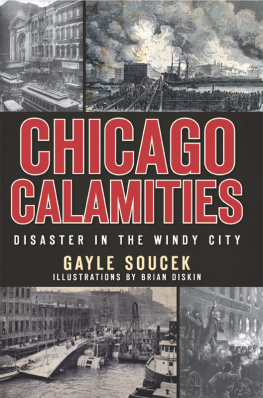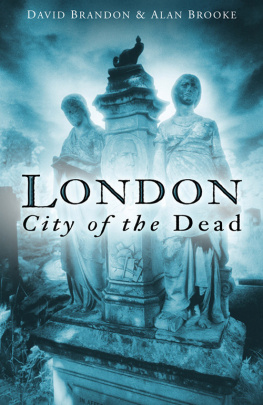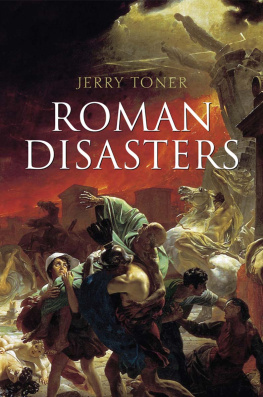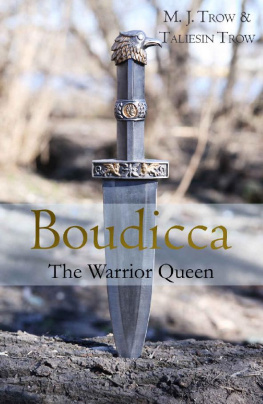LONDONS
DISASTERS
FROM BOUDICCA TO
THE BANKING CRISIS
JOHN WITHINGTON

For my father
First published in 2003
This edition first published in 2010
The History Press
The Mill, Brimscombe Port
Stroud, Gloucestershire, GL5 2QG
www.thehistorypress.co.uk
This ebook edition first published in 2011
All rights reserved
John Withington 2003, 2004, 2010, 2011
The right of John Withington, to be identified as the Author of this work has been asserted in accordance with the Copyrights, Designs and Patents Act 1988.
This ebook is copyright material and must not be copied, reproduced, transferred, distributed, leased, licensed or publicly performed or used in any way except as specifically permitted in writing by the publishers, as allowed under the terms and conditions under which it was purchased or as strictly permitted by applicable copyright law. Any unauthorised distribution or use of this text may be a direct infringement of the authors and publishers rights, and those responsible may be liable in law accordingly.
EPUB ISBN 978 0 7524 7624 7
MOBI ISBN 978 0 7524 7623 0
Original typesetting by The History Press
CONTENTS
ACKNOWLEDGEMENTS
I would like to thank the library staffs of the Health and Safety Executive, the London Fire Brigade and the London Fire Brigade Museum for their help and their patience. Above all, I would like to thank my wife, Anne, for her constant support.
PART ONE
HOSTILE ACTION
ONE
WAR AND INVASION
L ondon did not have to wait long for its first disaster. The city was founded by the Romans as Londinium around AD 50; a decade later, it lay in ruins the only time in its history that a disaster has completely destroyed it.
The Roman city was built around Cornhill and Ludgate. By AD 60, it had spread over about 30 acres and become a busy trading centre. The houses had timber frames and thatched roofs and most were probably owned by Romans, well-to-do Gauls and other foreigners. The chain of events that began Londiniums destruction started in modern-day Norfolk. There Prasutagus, King of the Iceni, had collaborated with the Romans and managed to construct a special relationship. His reward was to be allowed to remain semi-independent. Such arrangements, though, tended not to last beyond the death of the favoured individual.
In AD 61, the King died. He was survived by his widow Boudicca and two daughters. Prasutagus had hoped to safeguard their future by a will in which he left half of his considerable wealth to the Emperor Nero and half to his daughters. When he died, representatives of the procurator, the financial overlord of the province of Britain, appeared. They probably had instructions to seize the whole estate, but even if they did not, their arrogance and high-handedness provoked resistance.
The Romans responded brutally, flogging Boudicca and raping her daughters. It was not only the Iceni, though, whom they had alienated. The Icenis neighbours, the Trinovantes, whose territory lay in Essex and southern Suffolk, joined the Iceni. They bitterly resented having their lands and houses handed over to Roman war veterans, as well as the Romans efforts to make them worship the Emperor.
When the Britons went to war, the Roman Governor, Suetonius Paulinus, was campaigning far away in Anglesey with the XIVth Legion. In his absence, Boudiccas host sacked and looted Colchester, massacring its Roman colonists, and destroyed part of a Roman legion that had tried to come to their rescue. When Suetonius heard the news, he raced down to London. His cavalry probably made it in three or four days, but the infantry was left far behind. With his depleted force, he decided that if he was to save the province, he had to abandon the city. So, in the words of the Roman historian Tacitus, undeflected by the prayers and tears of those who begged for his help, he led his soldiers off to the north, taking with him those Roman Londoners fit and willing to escape. The rest he abandoned to their fate. Some may have escaped into the territory of neighbouring tribes still friendly to Rome, but many were reluctant to leave, and the old and infirm could not.
When Boudiccas army entered the city, the inhabitants were slaughtered. Tacitus complained the rebels did not want to take prisoners and make money from ransoms, they just wished to kill cutting throats, hanging and crucifying with a headlong fury. They also burned down the city. The fearful intensity of the fire is clear from the way a heap of Roman coins found near the northern end of London Bridge have been partially melted together, and in the Museum of London, there are remains of coins and pottery burned as the city was destroyed. The ruins of Roman London also contain reddish fire debris 18 inches thick, another tangible reminder of the citys first disaster.
Boudiccas followers carried the destruction across the river to the settlement at Southwark, then they swung back north and meted out similar treatment to St Albans. Tacitus claims they killed 70,000 people in all. The figure is almost certainly a gross exaggeration, but the massacre was nonetheless a terrible one. The campaign, though, was to end in another massacre, this time of Boudiccas host. It may have been 80,000 strong, but it was hampered by a long, unwieldy tail of women and children. Suetonius had probably gathered together a force of about 10,000, but its discipline and tactical sophistication enabled it to win a devastating victory. Tens of thousands of Britons were killed against just 400 Romans. Boudicca took poison rather than fall into the hands of her enemies.
Tradition has placed the fatal battle at a number of sites around London, like Stanmore Common to the north, or Honor Oak in the south. The favourite was Battle Bridge, near Kings Cross, with the body of Boudicca said to be buried at a site now occupied by one of the platforms of Kings Cross station, or under an ancient tumulus at Parliament Hill. No sign of the Queen was found, however, when the mound was excavated, and the view of historians nowadays is that the decisive battle probably took place in the Midlands.
Although Roman London was to encounter disaster from fire (see Chapter 5), in the two centuries after the defeat of Boudicca, it seems to have remained free from attack. Towards the end of the second century, however, work was begun on a major defensive wall and ditch on the landward side of the city, perhaps reflecting a fear that more turbulent times were on the way.
In 286, a Belgian named Marcus Carausius, hired by the Romans to fight barbarian pirates in the channel, declared himself Emperor of Britain. For ten years he and Allectus, who eventually deposed and murdered him, defied the Roman Empire. Then, in 296, Constantius Chlorus, who was the father of Constantine the Great and who would himself become Emperor, appeared to defeat and kill Allectus and win back Britain for Rome. Frankish mercenaries who had been hired by the rebel emperor, took refuge in London and began plundering the city. Fortunately for the citizens, some of Constantiuss ships sailed up the Thames. When the Franks saw them, they tried to escape, but, according to a contemporary account, the Romans slew them in the streets.
There was more trouble in 367 when the Saxons overran London. They were leaving loaded with plunder, driving prisoners in chains and cattle before them, when they were caught by the Roman general Theodosius, who had been despatched by the emperor. The Roman army routed the marauders and, when Theodosius entered the city, he was received with all the jubilation of a Roman triumph. Theodosius may also have strengthened Londons defences, and more work seems to have been done in the last decade of the fourth century too, but the barbarian tide could not be checked indefinitely, and besides, Rome was facing problems much nearer home, which meant it could no longer afford to protect outposts of the empire.













